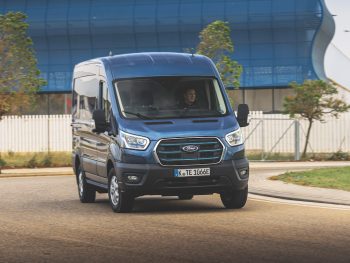As E-Transit makes its debut, John Kendall asks if it’s the best heavy electric van on the market.

A new Ford van is always going to generate a lot of interest in the UK, given the company’s dominance of the light CV market for close to 60 years. One that marks Ford’s entry into the electric van sector is bound to grab headlines.
Ford has retained the existing ‘2-Tonne’ Transit bodywork but, under the skin, the van has been comprehensively re-designed to accommodate a new electric drive system that will provide the blueprint for future electric Ford vans.
Ford is using the launch of E-Transit to substantially change how it sells light CVs with the simultaneous launch of Ford Pro, designed to offer a complete service to light CV customers. Ford Pro will include a range of services including software, charging, service and finance, as well as sales of the Ford commercial vehicle range.
As far as E-Transit is concerned, this was the first opportunity for Van Fleet World to drive Ford’s first electric van. Ford offered a range of van models to drive at the launch, powered by either a 184hp or 270hp electric motor, the two power options on offer with E-Transit. All models are rear-wheel drive, with an e-axle combining the motor and final drive mounted beneath the load floor. This arrangement also brings another ‘first’ for a rear-wheel drive Transit – standard independent rear suspension using coil springs. Air suspension is offered as an option. Both motors generate 430Nm of torque, while the 68kWh capacity battery will provide a range of up to 197 miles (WLTP), better than any of its current rivals. Ford’s optional ProPower onboard system uses software to partition part of the battery pack to provide 2.3kW of power for tools.
Ford offers two trim specifications – Leader and Trend – with standard equipment including electronic air temperature control, keyless start, heated seats, Quickclear windscreen and heated electric door mirrors. FordPass Connect modem will also be standard on all E-Transits.
In addition, Trend models will gain Ford Connected Navigation, including Intelligent Range to provide a more accurate indication of remaining range. Enhanced voice control and Amazon Alexa will also be available with Trend models. A range of driver assistance systems will be on offer, including the new Reverse Brake Assist. This system uses a camera and sensors to detect vulnerable road users and static objects while reversing and provides a warning with automatic stopping if the driver does not react. Other assistance systems include PreCollision Assist with Pedestrian Detection and Junction Assist, among others.
First impressions on the road are that E-Transit sets new refinement standards for electric vans, with low interior noise levels and impressive noise suppression. As you might expect from the relatively high power available, there’s no shortage of performance, with plenty available for all load conditions. The E-Transit offers speed-limiting options to help maximise range.
Ford provides two ways to access regenerative braking. The first is to press ‘L’ in the centre of the dashboard drive selector, which will provide permanent regenerative braking when lifting off, all the time ‘L’ is selected. Alternatively, a single tap on the brake pedal will provide a lower level of regen braking or two taps will provide the maximum.
Eco, Normal and Slippy drive modes bring no surprises – Eco limits power to 184hp for 270hp models and also cuts top speed to conserve range.
We will bring you a full test later in the year, but it looks as though Ford is set to shake up the market for heavy electric vans.
In Brief:
What is it? Heavy van
How much? From £47,700 (ex VAT)
Load volume? Up to 15.1m3
Payload? Up to 1,758kg
Range? Up to 197 miles (WLTP)
Drive? Battery electric with 184hp or 270hp electric motor

